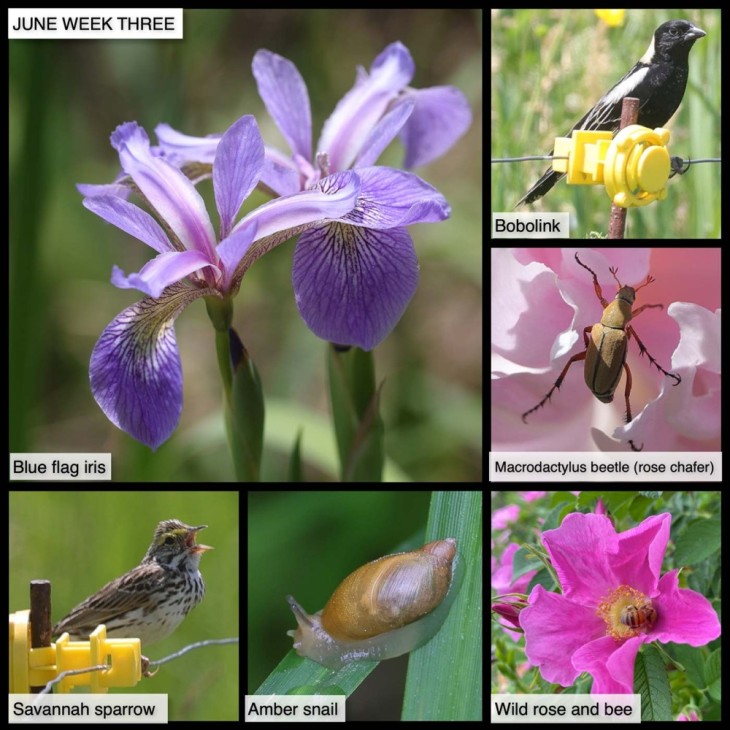This Week in the Woods we discovered blue flag irises blooming by a forested pond, attended by a number of small butterflies. As Laurie Morrisey notes in this recent Outside Story essay, blue flag is our most common native iris. It may be found growing on the same wetland edge as its good-looking but ne’er-do-well cousin, the invasive yellow flag iris, which crowds out other vegetation. The name iris derives from the Greek name for the goddess of the rainbow.
Here are some other nature sights this week (clockwise):
We were excited to see several nesting pairs of bobolinks this past weekend in a large upland field. These ultra-long-distance migrators (they fly thousands of miles to wintering grounds in the South American Pampas) have experienced a continued population decline, largely due to loss of habitat. Bobolinks typically nest in large, grassy fields – which unfortunately makes them vulnerable to early summer mowing. As Li Shen notes in this Outside Story essay from our archive, landowners who delay mowing until late July can help these and other field nesting birds successfully raise their young. Here’s a link to an innovative conservation effort, The Bobolink Project, that connects farmers with donors who provide funds to make mowing delays in bobolink habitat affordable.
For years, we’ve been blithely assuming that those mustard-colored beetles that show up on peonies and other garden flowers are pollinators. Nope. They’re beetles in the Macrodactylus genus and are commonly called rose chafers for their habit of feeding on petals. Adults lay eggs in July, and the larvae feed on plant roots. We’re taking a live-and-let-bite-the-flowers approach, but if you choose to remove the beetles from your prized blooms, don’t feed them to chickens. As noted in this profile from the University of Minnesota, rose chafers have toxins in their bodies that can kill birds and small animals.
Virginia rose and Carolina rose, two common look-alike species of wild rose, are both blooming now. The plants’ big, beautiful flowers are highly attractive to bees, and as noted in this profile of Virginia rose from the Lady Bird Johnson Wildflower Center, wild roses can also provide nesting materials for native bees. Look for them in open, sunny areas, such as meadows and roadsides.
There are many species of Succinae or amber snails – some native, some not – and it’s difficult sorting them out (our best guess is that the one in the photo is a common European amber snail). As a group, they typically live in wetland habitats and have thin, semi-transparent shells. Here’s a description of work at SUNY-ESF to protect an endangered amber snail species, the Chittenango Ovate, through a combination of picky leaf selection and a carefully-monitored Tupperware terrarium.
In the same field where we saw bobolinks – and perched along the same wire – we also found another grassland bird, a Savannah sparrow. As noted in this profile from Cornell, and demonstrated in the photo, “The crown feathers often flare up to give the bird’s head a small peak.” Even if you’ve never noticed these members of the “little brown bird” club before, chances are you’ll recognize their buzzy call – a classic sound of summer meadows. This is another bird species that benefits from delayed mowing.
Our thanks to The Bailey Charitable Foundation and the Frank and Brinna Sands Foundation for helping to support this series.
In this difficult period, many of us find joy in observing local nature. This series, launched in April 2020, shares nature photographs taken in the past seven days, or in the same week in 2020, most within 15 miles of the Northern Woodlands office in Lyme, New Hampshire. We hope you enjoy using this grid as a prompt for your own explorations.
What are you seeing in the woods this week? Share your images with us on Facebook, or submit a special photo for possible inclusion in our monthly online Reader Photo Gallery.


